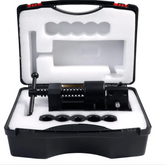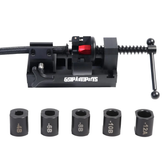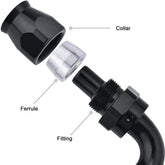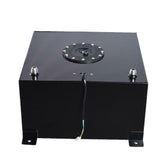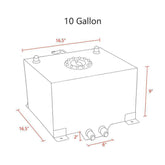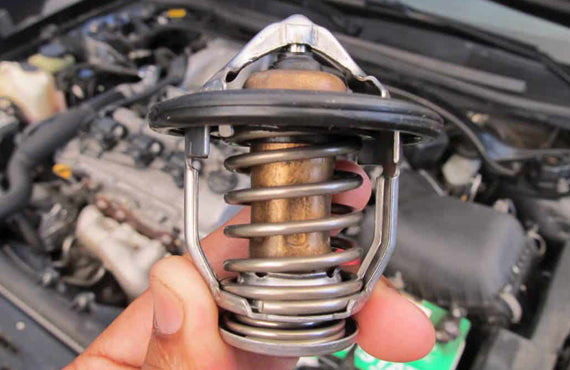A thermostat is an automatic temperature regulating device that usually contains a temperature sensing element. Opens and closes the flow of coolant by expanding or contracting, i.e. automatically adjusting the amount of water entering the radiator according to the temperature of the radiator. Coolant, change the coolant circulation range to adjust the heat dissipation capacity of the cooling system.

The thermostat used by the engine is mainly a wax type thermostat, which controls the circulation of the coolant through the principle of thermal expansion and contraction of the internal paraffin. When the cooling temperature is lower than the specified value, the refined paraffin in the thermostat temperature sensing body is solid. The thermostat valve closes the passage between the engine and the radiator under the action of the spring, and the coolant returns to the engine through the water pump for internal cooling of the machine—a small circuit. When the temperature of the cooling liquid reaches the specified value, the paraffin wax begins to melt and gradually becomes liquid, and the volume increases accordingly and the rubber tube is compressed to make it shrink. When the rubber tube contracts, an upward thrust is applied to the push rod, and the push rod acts on the valve. The downward counterthrust opens the valve. At this time, the coolant passes through the radiator and thermostat valves, and then flows back to the engine through the water pump to perform a large cycle. Most of the thermostats are arranged on the water outlet pipe of the cylinder head. The advantage of this method is that the structure is simple, and it is easy to discharge the air bubbles in the cooling system; the disadvantage is that the thermostat is often switched on and off during operation, causing oscillation.

When the engine operating temperature is low (less than 70°C), the thermostat automatically closes the channel to the radiator and the channel to the water pump. The cooling water flowing out of the water jacket enters the water pump directly through the hose, is drawn into the water jacket and then circulated. Because the cooling water does not dissipate heat through the radiator, the operating temperature of the engine will rise rapidly. This kind of circulation route is called a small loop. When the operating temperature of the machine is high (above 80°C), the thermostat automatically closes the passage to the water pump and the passage to the radiator. Sleeves add cooling strength and prevent engine overheating. This cycle is known as the grand cycle. When the working temperature of the machine is between 70 and 80°C, large circulation and small circulation exist at the same time, that is, part of the cooling water performs large circulation, and another part of cooling water performs small circulation.
What the car thermostat does is shut down the car until the temperature reaches normal temperature. At this time, the coolant of the engine returns to the engine through the water pump, and performs a small circulation in the engine, so that the engine heats up rapidly. It can be opened when the normal temperature is exceeded, allowing the coolant to circulate through the entire radiator circuit of the tank, dissipating heat quickly.

The thermostat used by the engine is mainly a wax type thermostat, which controls the circulation of the coolant through the principle of thermal expansion and contraction of the internal paraffin. When the cooling temperature is lower than the specified value, the refined paraffin in the thermostat temperature sensing body is solid. The thermostat valve closes the passage between the engine and the radiator under the action of the spring, and the coolant returns to the engine through the water pump for internal cooling of the machine—a small circuit. When the temperature of the cooling liquid reaches the specified value, the paraffin wax begins to melt and gradually becomes liquid, and the volume increases accordingly and the rubber tube is compressed to make it shrink. When the rubber tube contracts, an upward thrust is applied to the push rod, and the push rod acts on the valve. The downward counterthrust opens the valve. At this time, the coolant passes through the radiator and thermostat valves, and then flows back to the engine through the water pump to perform a large cycle. Most of the thermostats are arranged on the water outlet pipe of the cylinder head. The advantage of this method is that the structure is simple, and it is easy to discharge the air bubbles in the cooling system; the disadvantage is that the thermostat is often switched on and off during operation, causing oscillation.

When the engine operating temperature is low (less than 70°C), the thermostat automatically closes the channel to the radiator and the channel to the water pump. The cooling water flowing out of the water jacket enters the water pump directly through the hose, is drawn into the water jacket and then circulated. Because the cooling water does not dissipate heat through the radiator, the operating temperature of the engine will rise rapidly. This kind of circulation route is called a small loop. When the operating temperature of the machine is high (above 80°C), the thermostat automatically closes the passage to the water pump and the passage to the radiator. Sleeves add cooling strength and prevent engine overheating. This cycle is known as the grand cycle. When the working temperature of the machine is between 70 and 80°C, large circulation and small circulation exist at the same time, that is, part of the cooling water performs large circulation, and another part of cooling water performs small circulation.
What the car thermostat does is shut down the car until the temperature reaches normal temperature. At this time, the coolant of the engine returns to the engine through the water pump, and performs a small circulation in the engine, so that the engine heats up rapidly. It can be opened when the normal temperature is exceeded, allowing the coolant to circulate through the entire radiator circuit of the tank, dissipating heat quickly.

